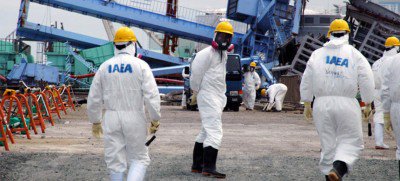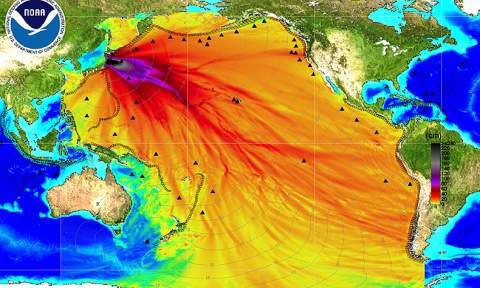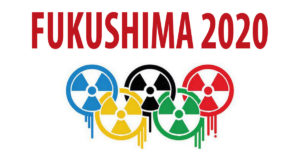The Fukushima Nuclear Disaster and Its Tragic Aftermath
ENVIRONMENT, ASIA--PACIFIC, ENERGY, 19 Aug 2019
Rossen Vassilev Jr. – Global Research
The Worst Nuclear Accident in History
14 Aug 2019 – The three meltdowns and at least four big core explosions at the Fukushima nuclear-power plant’s six American-designed Daiichi reactors in March 2011 still constitute the world’s worst nuclear nightmare so far, surpassing even the Chernobyl #4 reactor’s explosion and meltdown of April 1986. While Chernobyl’s disaster was very quickly contained albeit at the cost of at least 30 human lives (according to Soviet sources)—by first having the stricken reactor completely buried in sand from the air and then immediately sealing it inside a sarcophagus of reinforced concrete, Fukushima’s tragedy has remained an open, festering wound to this day. A U.N. report issued in 2012 stated that at least six Fukushima workers had died since the meltdowns and the tsunami (according to a later report by the Japanese government, only one of these workers had died from radiation exposure).
The Japanese seem to have been reluctant to risk the lives of their more than 6,000 rescue workers pouring daily hundreds of tons of sea water over the fully destroyed reactors as well as the several partly damaged ones. Yet, as of 27 February 2017, the Fukushima prefecture government counted 2,129 “disaster-related deaths” in that prefecture alone. At least 1,368 among those deaths have been listed as directly “related to the nuclear power plant.” Predicted future cancer deaths due to accumulated radiation exposures in the population living near Fukushima are expected to run in the many hundreds, if not the thousands.
Obviously, the Japanese government’s wishful thinking is that the nuclear disaster would just go away if as few people as possible—both at home and especially abroad—knew about its true extent and actual severity. According to Harvey Wasserman (“14,000 Hiroshimas Still Swing in Fukushima’s Air,” The Free Press, October 9, 2013), the situation on the ground was still rather catastrophic more than two years after the disaster, because
“Massive quantities of heavily contaminated water are pouring into the Pacific Ocean, dousing workers along the way. Hundreds of huge, flimsy tanks are leaking untold tons of highly radioactive fluids. At Unit #4, more than 1300 fuel rods, with more than 400 tons of extremely radioactive material, containing potential cesium fallout comparable to 14,000 Hiroshima bombs, are stranded 100 feet in the air.”
Have we been witnessing a major local catastrophe with some perilous global repercussions that are still being concealed from the general public and the world under a veil of total government secrecy—“apparently to avoid causing ‘needless’ social panic,” in the words of Japanese research scientist Haruko Satoh (“Fukushima and the Future of Nuclear Energy in Japan: The Need for a Robust Social Contract,” ARI, June 29, 2011)? While the Russians had the excuse of having just one prior warning—namely that of the Three Mile Island’s much smaller nuclear mishap in the U.S. on March 28, 1979—the Japanese appear to have completely ignored Chernobyl’s tragic lessons while operating their Fukushima nuclear-power plant built in a highly vulnerable seismic zone in close proximity to the Pacific Ocean which is prone to massive earthquakes and tsunamis. Pointing out that
“…a vast area of land has been contaminated by radiation,” Haruko Satoh further writes that “…the nature of the on-going nuclear crisis is better understood as a man-made disaster resulting from the systemic failure of Japan’s nuclear energy regime for safety than an inevitable consequence of unforeseen forces of nature.”
In his considered opinion, Japan “has also failed to act speedily to remove and treat the accumulating contaminated soil and water” (ibid.).
As a result, according to The Guardian (“Plummeting Morale at Fukushima Daiichi as Nuclear Cleanup Takes Its Toll,” October 15, 2013), “the world’s most dangerous industrial cleanup” has been threatening not only Japan (long dubbed “America’s unsinkable aircraft carrier” in the western Pacific) but the rest of the planet as well. Will the international community finally wake up to this still on-going lethal danger that will persist for many years to come—at least until the afflicted nuclear reactors are finally cooled down? But it is not going to be an easy job since by Tokyo’s own estimates the full decommissioning of the wrecked nuclear site could take up to 40 years.
Could the 2020 Tokyo Olympics be canceled?
The Fukushima catastrophe released in the air many radioactive pollutants such as cesium-134, cesium-137, strontium-90, iodine-131, plutonium-238 and other so-called radionuclides that emit ionized (alpha and beta) particles. With lifespan exceeding hundreds of years, these radioactive pollutants will continue to pose a radiation threat for many decades to come. One eyewitness testifies about the failure of Japan’s decontamination measures (Maxime Polleri, “The Truth About Radiation in Fukushima: Despite Government Claims, Radiation From the 2011 Nuclear Disaster Is Not Gone,” The Diplomat, March 14, 2019):
“…mountains of black plastic bags, filled with contaminated soil or debris, can be seen in many parts of Fukushima…. As such, decontamination does not imply that radiation has vanished; it has simply been moved elsewhere. Yet in rural regions, where many of the bags are currently being disposed, far away from the eyes of urban dwellers, residents are still forced to live near the storage sites. Many rural residents have criticized the actual efficacy of the decontamination projects. For instance, vinyl bags are now starting to break down due to the build-up of gas released by rotten soil. Plants and flowers have also started to grow inside the bags, in the process tearing them apart. With weather factors, residual radioactivity inside the bags will eventually be scattered back into the environment.”
But with the upcoming 2020 Tokyo Olympics, it is doubtful that the secretive Japanese government will ever acknowledge this threatening reality. For example, the Japanese have been silent about the current extent of radiological contamination of the seas surrounding Japan—obviously for fear that the Tokyo Olympics scheduled to be held next year may be canceled.
In the past, the Tokyo Electric Power Company (Tepco), the crippled nuclear-power plant’s sole owner and operator,
“has all but admitted (that) Fukushima’s radiation leaks are spiraling out of control. In addition to the leaking water storage units that are unleashing hundred of tons of radioactive water each day, Tepco now says (that) 50% of its contaminated filtration capability has been taken offline due to corrosion. The result is that radiation leaks are escalating out of control and attempted remediation efforts are faltering” (“Fukushima in Free Fall,” NaturalNews.com, August 27, 2013).
The traditionally close-mouthed Japanese bureaucrats have been far less truthful and much more evasive about the gravity of the Fukushima nuclear crisis than the Russians ever were about their Chernobyl disaster. Only in June 2011—three whole months after the Fukushima nuclear accident—did Tokyo announce that meltdowns had actually occurred in three of the six reactors. “From day one,” the NaturalNew.com article continues,
“the Fukushima fiasco has been all about denial: Deny the leaks, shut off the radiation sensors, black out the news and fudge the science. Yet more than two years later, the denials are colliding with the laws of physics, and Tepco’s cover stories are increasingly being blown wide open.” (ibid.)
Buried under a virtual tsunami of compensation-seeking lawsuits, Tepco, “once a behemoth that virtually controlled Japan’s energy policy“ (Haruko Satoh, “Fukushima and the Future of Nuclear Energy in Japan: The Need for a Robust Social Contract,” ARI, June 29, 2011), has survived to this day as Japan’s biggest energy giant only thanks to the LDP government which seems to be more than willing and eager to bail it out. Despite the attempted cover-up by pro-nuclear Japanese cabinets and the Japanese news media alike, Japan’s own nuclear-safety watchdog—the Nuclear and Industrial Safety Agency (NISA)—gave Fukushima’s nuclear catastrophe the worst possible rating for radiological danger, Level 7 (“major accident”)—the same rating as the Chernobyl disaster—in accordance with the International Nuclear and Radiological Event Scale (INES) standards established by the International Atomic Energy Agency (IAEA) in 1990.
Read more: Japan Plans to Expose Its People and 2020 Tokyo Olympians to Fukushima Radiation
Showing how more than two years after the disaster the waters of the Pacific Ocean were actually “boiling” off the coast of Fukushima in what it called “a viral photo of the day,” Before It’s News (“’Boiling Sea’ Off Fukushima Viral Photo of the Day,” August 30, 2013) asked rhetorically, “…if this radiation keeps leaking, and there is no way to stop it, will boiling seas spread all the way across the Pacific Ocean to the West Coast of the United States? If so, what happens then?”
How was the critically important oceanic animal and plant life affected by the radioactive contamination? Tokyo has denied that due to higher radiation levels it is dangerous to eat any fish caught by Japanese fishermen, but the government has reinstated its earlier fishing ban. Could it be that all of Japan has been poisoned? Moreover, is the whole planet going to be eventually contaminated by Fukushima’s many tons of radioactive material released into the air and sea? Again according to Harvey Wasserman,
“A worst-case cloud would eventually make Japan an uninhabitable waste-land. What it could do to the Pacific Ocean and the rest of us downwind approaches the unthinkable” (“14,000 Hiroshimas Still Swing in Fukushima’s Air,” The Free Press, October 9, 2013).
The Fukushima nuclear accident and its tragic consequences have taken place at the worse possible time for Japan, given its huge national debt (which is more than twice the size of its annual GDP) and protracted economic slump lasting now for almost three decades. Japan’s economic downturn started with the bursting of Tokyo’s stock-market and real-estate “bubbles” in the 1990s and was gravely exacerbated by the global Great Recession of 2008-2009 sparked by America’s own banking and real-estate crises. The international community should have by now pressed the U.N. Security Council to consider and adopt a binding resolution to close down Japan’s hazardous nuclear-energy industry, given the major economic, public health and public safety risks involved.
Is Japan’s nuclear industry doomed?
But Japan’s nuclear power may already be doomed, with its nuclear units being gradually taken “offline” in the wake of the Fukushima fiasco (“After Fukushima, Does Nuclear Power Have a Future?” The New York Times, October 10, 2011). In September 2013, the new Liberal Democratic Party Prime Minister Shinzo Abe ordered the shutdown—supposedly for routine maintenance and safety checks—of its last nuclear reactor at Oi that was still working after all the other 53 operating reactors had been closed down for one reason or another. Facing pressure from the Japanese public which has turned decisively against nuclear energy, the previous Prime Minister, Yoshihiko Noda of the Democratic Party of Japan, had announced in September 2012 a major change in Japan’s energy policy, pledging to shut down all nuclear power for good by the 2030s, thus angering the all-powerful Japanese captains of industry.
In power since December 2012, Shinzo Abe’s LDP cabinet has been warning about the steep economic costs of pulling the plug on Japan’s nuclear energy, mainly in the form of escalating and very expensive energy imports, especially for a country which lacks fossil fuel reserves. Under tremendous pressure from the “iron triangle” community of electricity utilities, heavy industry, ministry bureaucrats and academic experts, known as the “nuclear village,” Prime Minister Shinzo has been trying to restart as many nuclear reactors as the still hostile domestic public opinion would permit him.
Following the Fukushima accident, as each Japanese nuclear reactor entered its scheduled maintenance and refueling outage, it was not returned to operation. Between September 2013 and August 2015, Japan’s entire reactor fleet was suspended from operation, leaving the country with no nuclear generation. But in 2018 Prime Minister Shinzo’s cabinet restarted five nuclear power reactors (U.S. Energy Information Administration, “Japan Has Restarted Five Nuclear Power Reactors in 2018,” November 28, 2018). He is facing a new and unexpected obstacle—the renewed and strengthened Nuclear Regulation Authority (NRA), which had been reformed and given more regulatory powers and administrative independence after Fukushima, especially since this now independent agency has to declare any nuclear plants safe before they could restart. There is also the implacable opposition of many prefectures, towns and villages which, under the law, have a say over the reopening of any local or nearby nuclear plants (“Electricity in Japan: Power Struggle,” The Economist, September 21, 2013). In spite of the determination of the ruling LDP to keep Japan’s ailing nuclear industry alive, its days may already be numbered (Sumiko Takeuchi, “Is There a Future For Nuclear Power in Japan?” Japan Times, July 16, 2019).
______________________________________________
Rossen Vassilev Jr. is a journalism senior at the Ohio University in Athens, Ohio.
Copyright © Rossen Vassilev Jr., Global Research, 2019
Go to Original – globalresearch.ca
Tags: Capitalism, Chernobyl, Conflict, Economics, Energy, Environment, Fukushima, Geopolitics, History, Human Rights, Indigenous Rights, International Relations, Japan, Nuclear Disaster, Nuclear Energy, Nuclear Meltdown, Nuclear Power, Politics, Power, Social justice, Three Mile Island, World
DISCLAIMER: The statements, views and opinions expressed in pieces republished here are solely those of the authors and do not necessarily represent those of TMS. In accordance with title 17 U.S.C. section 107, this material is distributed without profit to those who have expressed a prior interest in receiving the included information for research and educational purposes. TMS has no affiliation whatsoever with the originator of this article nor is TMS endorsed or sponsored by the originator. “GO TO ORIGINAL” links are provided as a convenience to our readers and allow for verification of authenticity. However, as originating pages are often updated by their originating host sites, the versions posted may not match the versions our readers view when clicking the “GO TO ORIGINAL” links. This site contains copyrighted material the use of which has not always been specifically authorized by the copyright owner. We are making such material available in our efforts to advance understanding of environmental, political, human rights, economic, democracy, scientific, and social justice issues, etc. We believe this constitutes a ‘fair use’ of any such copyrighted material as provided for in section 107 of the US Copyright Law. In accordance with Title 17 U.S.C. Section 107, the material on this site is distributed without profit to those who have expressed a prior interest in receiving the included information for research and educational purposes. For more information go to: http://www.law.cornell.edu/uscode/17/107.shtml. If you wish to use copyrighted material from this site for purposes of your own that go beyond ‘fair use’, you must obtain permission from the copyright owner.
Read more
Click here to go to the current weekly digest or pick another article:
ENVIRONMENT:
- COP30’s Three F-Words: Failure on Fossil Fuels
- Declaration of the Peoples’ Summit Towards COP30
- Plutonium Found at Former San Francisco Naval Shipyard – Navy Faces Cover-Up Claims
ASIA--PACIFIC:
- Genocide Emergency: Xinjiang, China 2025
- Prisons as Sites of National Reconciliation or Continuing Hells
- Japan’s Push Toward “Aggressive Militarist Ambitions” Raises Alarms for Asia-Pacific and World Peace
ENERGY:


